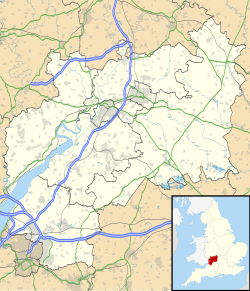RAF Pucklechurch was a Royal Air Force site in Pucklechurch, Gloucestershire from 9 August 1939 until 31 December 1959. It became known as RAF Pucklechurch on 16 June 1952. It was transferred to HM Prison Service in September 1962 and became Pucklechurch Remand Centre.
| RAF Pucklechurch | |
|---|---|
| Located near Pucklechurch in Gloucestershire | |
| Coordinates | 51°28′52″N 2°26′10″W / 51.4811°N 2.4361°W |
| Type | Balloon Centre |
| Site information | |
| Owner | Air Ministry |
| Controlled by | Royal Air Force |
| Site history | |
| Built | 1939 |
| In use | 1939-1959 |
| Garrison information | |
| Garrison | RAF Balloon Command RAF Maintenance Command |
History
editDuring the war barrage balloons were an important defence to the industry and transport sites in the Bristol region.[1][2] There were large hangars and fuel storage facilities. Pucklechurch was under the command of the RAF Filton station commander.
From April 1957 to September 1959 it housed the Joint Services School for Applied Linguistics and the RAF Chinese Language School.[3]
Operational commands
edit- Opened – 9 August 1939 (as No. 11 Balloon Centre)
- RAF Balloon Command (9 August 1939 – 22 April 1945)
- RAF Maintenance Command (22 April 1945 – 25 February 1947)
- No. 62 Group RAF (25 February 1947 – 14 January 1957)
- No. 61 Group RAF (14 January 1957 – 31 December 1959)
- Closed – 31 December 1959
Current use
editSince September 1962 it became Pucklechurch Remand Centre and later Ashfield Young Offender Institution.[4]
See also
editReferences
editCitations
edit- ^ Penny, John. "A Short History of RAF Pucklechurch," (PDF). Fishponds Local History Society. Archived (PDF) from the original on 12 October 2013. Retrieved 28 August 2020.
- ^ "Barrage Balloon Mooring Site, east of 57 Oak Tree Avenue". National Heritage List for England. Historic England. Archived from the original on 28 August 2020. Retrieved 28 August 2020.
- ^ "History of the RAF Chinese Language School". Archived from the original on 14 February 2010. Retrieved 16 June 2009. Archived 14 February 2010 at the Wayback Machine
- ^ "Monument No. 1594751". Pastscape. Historic England. Archived from the original on 28 August 2020. Retrieved 28 August 2020.
